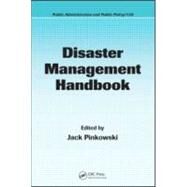- ISBN: 9781420058628 | 1420058622
- Cover: Hardcover
- Copyright: 1/22/2008
Record breaking hurricane seasons, tornados, tsunamis, earthquakes, and intentional acts of mass-casualty violence, give lie to the delusion that disasters are the anomaly and not the norm. Disaster management is rooted in the fundamental belief that we can protect ourselves. Even if we cannot control all the causes, we can prepare and respond. We can craft constructive, workable policy that will contribute to the prevention of enormous financial impact, destruction of the environment, and needless loss of life. Integrating scholarly articles from international experts and first hand accounts from the practitioner community, Disaster Management Handbookpresents an analytical critique of the interrelated, multidisciplinary issues of preparedness, response, and recovery in anticipating and rebuilding from disasters. Beginning with an introduction to the theoretical constructs and conceptual foundations of disaster management, the book reviews the relationship of modern development todisaster vulnerability, the politics of disaster management, leadership, and the role of agency coordination. The second and third sections examine case studies and lessons learned through natural disasters in North America and around the world. They compare and contrast the efficacy of different management strategies from national, provincial, and local governments, as well as non-governmental agencies. Taking a narrower scope, the fourth section focuses on emergency personnel and the methods and issues faced in on-the-scene response and preparation. It also considers the special needs of hospitals and the effective use of the media. Contributions in the final two sections present strategies for limiting and ameliorating the psychological impact of disaster on victims and personnel, and look forward to how we can be better prepared in the future and rebuild stronger, more resilient communities.







